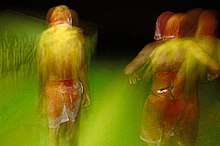Self-flagellation
Self-flagellation is the disciplinary and devotional practice of flogging oneself with whips or other instruments that inflict pain.[1] This ritual first took hold among the members of several Greco-Roman and Egyptian cults such as the cults of Isis and the Sparta Artemis Orthia. It was not until the practice of self-flagellation was eventually adopted by Christians that it became a spiritual act.[2] It is practiced throughout many different religions around the world stemming from the idea that the willingness to self-inflict harm to the body will bring salvation and drive out evil. It is often used as a form of penance, purification, and initiation.[3] The main religions that practice self-flagellation include Christianity, Judaism, Shia Islam, and Hinduism and Buddhism.
Overview
Pain and suffering has always been a major part of one’s understanding of religion. Practices that induce pain have been able to transcend many different religions and cultures. While the methods used to inflict this pain may vary, the reasons behind this peculiar ritual seem to be very similar. A common goal of self-flagellation is the desire to emulate a certain prophet. Another main reason for this ritual is the idea that pain causes evil to exit the body. Self-flagellation was often seen as a form of punishment and penance. Despite the gruesome nature of this ritual, many cultures associate it with redemption and purity. While it emerged centuries ago, it is still a ritual that exists today in many parts of the world.
Christianity

The Flagellation refers to the Flagellation of Christ. The practice of mortification of the flesh for religious purposes throughout most of Christian history, especially in Catholic monasteries and convents. Self-flagellation was imposed as a form of punishment as a means of penance for disobedient clergy and laity.[4]
In the 13th century, a group of Roman Catholics, known as the Flagellants, took this practice to its extreme ends. For example, it became a way to try to combat the plague through mitigation with the divine. The Flagellants were later condemned by the Roman Catholic Church as a cult in the 14th century because the established church had no other control over the practice than ex-communication. Self-flagellation was not exclusive to Europe.
This ritual was also found in 16th century Japan. When Jesuit missionaries traveled the world trying to convert people to Christianity, the Japanese proved to be very persuadable. They had a lot of sympathy for the Passion of the Christ, and they readily practiced self-flagellation to show their devotion. The earliest records of self-flagellation practiced by Japanese converts appeared in the year 1555 in the regions of Bungo and Hirado in Kyushu.[5] These Japanese Christians wore crowns of thorns and bore crosses on their backs during the procession, which led to the place they had designated as the Mount of the Cross.[6]
This practice also exists in the Philippines. As part of a Lenten ritual called penitensya, hooded penitents whip themselves publicly as they walk.
Through the years, Christianity has formed a permanent tradition of mortification, ranging from self-denial, wearing hairshirts and chains, fasting and self-flagellation all the way to self-castration.[7] Many Christians use excerpts from the Bible to justify this ritual. For example, some interpreters claim that St. Paul’s statement: ‘I chastise my body’ refers to self-inflicted bodily scourging (1 Corinthians 9:27).[8] There are many prominent Christians who have practiced self-flagellation. Martin Luther, the Protestant Reformer, regularly practiced self-flagellation as a means of mortification of the flesh.[9] Likewise, the Congregationalist writer Sarah Osborn also practiced self-flagellation in order "to remind her of her continued sin, depravity, and vileness in the eyes of God".[10] It became "quite common" for members of the Tractarian movement within the Anglican Communion to practice self-flagellation using a discipline.[11]

Christians give various reasons for choosing to self-flagellate. One of the main reasons is to emulate the suffering of Christ during his Passion. As Jesus was whipped before his crucifixion, many see whipping themselves as a way to be closer to Jesus and as a reminder of that whipping[12]. Many early Christians believed that in order to be closer to God, you needed to literally suffer through the pain of Christ.[13] The pain also helps people reduce feelings of self-consciousness and individuality. This allows Christians to feel closer to God. Additionally, Paul alluded to inflicting harm on yourself to feel closer to God in both his letter to the Romans and to the Colossians[14]. Self-flagellation is both done in public and in private.[15]
Resolution of guilt is another reason. Psychological studies have shown that causing pain to oneself reduces feelings of guilt. People feel that because they’ve inflicted pain on themselves, they have paid the price for their sins,[16] and shown God that they are remorseful for their sins.[17]
Self-flagellation was also seen as a form of purification, purifying the soul as repentance for any worldly indulgences. Self-flagellation is also used as a punishment on earth in order to avoid punishment in the next life.[18] Self-flagellation was also seen as a way to control the body in order to focus only on God. By whipping oneself, one would find distraction from the pleasures of the world and be able to fully focus on worshipping God[19]. Additionally, before Christianity was legalized in the Roman Empire, the ultimate expression of faith was martyrdom. However, once Christianity was legalized, Christians had to endure other forms of suffering in order to be more pious. While some practiced asceticism, slept on boards, or performed other forms of suffering, others would self-flagellate.[20] Self-flagellation is also done to thank God for responding to a prayer or to drive evil spirits from the body[21]. Self-flagellation is now uncommon because people have discovered how unhealthy the practice can be, and pious Christians have moved towards healthier practices of suffering, like fasting in moderation.[22]
There is still some controversy within the Christian tradition about whether or not self-flagellation should be permitted. Many churches and Christian leaders around the world have condemned the practice, but Pope John Paul II was said to self-flagellate. Despite the condemnation, this has not prevented the practice. There are still parades in Mexico, the Philippines, and other nations during Holy Week. Devotees carry one hundred pound crosses and whip themselves on the back with their faces covered to avoid legal consequences in places where the practice is banned.[23]
The Catholic church holds the general view that they will not prevent this practice, but they discourage it. It believes that because Jesus already suffered and died for humanity, humans do not have to suffer in order to be closer to him. However, some people still believe that they need to suffer as Jesus did, and continue this practice every year with an audience.[24]
Judaism
Another religion that participates in self-flagellation is Judaism. The Jewish community has practiced self-flagellation as a way to create a high moral standard.[25] Many religions believe that pain and suffering leads to salvation and purity. During the Middle Ages, Jewish men would practice self-flagellation on the day before Yom Kippur. Passages such as “it shall be a holy convocation unto you; and ye shall afflict your souls” (Leviticus 23:27) were used to justify these actions. They used whips to themselves on the back 39 times.[26] To put this into context, Norman Toby Simms explained, “Understanding what this kind of collective blood-letting means or how it functions in the middle of a civilized society is one thing — a study of the anthropology of culture, a history of religion, a deep psychological analysis of troubled souls; seeing the way in which it could be used at many levels of conscious and unconscious simulation/dissimulation by diverse groups of people seeking to deny, defer, define and redefine their place in history is another — a study, such as this, with aesthetic, dramatic and witty aims in mind.”[27]
Shia Islam

Much of the Twelver Shia Islam community tries to emulate Imam Husain through self-flagellation in the same ways that the Christians tried to emulate Jesus Christ. This is exhibited through the public performance of matam. The Shia counterpart to a Christian flagellant was called a matamdar. This ritual of matam is meant to reaffirm one’s faith and relationships by creating a deep bond among the participants through their shared religious devotion. Despite the violent nature of this ritual, the love and vulnerability associated with it makes it a fundamentally positive and affirmational ritual performance.[28] Many Shia communities worldwide march in massive parades every year on the Day of Ashura, during the mourning of Muharram, to commemorate the Battle of Karbala and the martyrdom of Imam Hussein. During these parades, devotees hit themselves on the chest or slash themselves with blades on chains called zanjerzani. Though it is uncommon, some Shia communities hit themselves on the back with chains and sharp objects such as knives. This happens in many countries including India, Pakistan, Iraq, Afghanistan, Iran, Saudi Arabia, Lebanon, United States,[29] and Australia.
Self-flagellation is just as controversial in Islam as it is in Christianity. There was a case in Manchester UK where a Shia family forced their children to self-flagellation, which brought condemnation upon the entire practice. Muslims responded saying that forcing your children to do this is wrong, but the practice as done by a consenting adult should not be condemned as it is essential to their faith[30]. However, many Shia leaders realize that this practice, though only performed during Ashura, is another thing that could give the world a bad view of Muslims. Some leaders have recommended donating blood instead of self-flagellation in order to bleed in remembrance of Hussein’s sacrifice[31].
Hinduism
For the Hindu religion, self-flagellation is generally not common. However, body piercing practices can be seen in Mauritius during the annual Thaipusam festival. This is a celebration of the Hindu god Murugan. During this festival, a Kavadi, essentially a physical burden, is carried by the pilgrim.[32] In the festival of Thaipusam, a ritual known as kavadi is also performed. It ranges from carrying heavy weights uphill to piercing the body, face and tongue with skewers, or dangling from hooks passed through the back and legs. Intense preparation and purification are undertaken for at least 48 days. These include adherence to a vegetarian diet, special daily prayers, sleeping on the floor, abstinence from sex, avoiding all intoxicants, etc., to prepare mind and body for the challenging task. Devotees frequently claim to experience no pain.[33]
See also
References
- Abbott, Geoffrey. "Flagellation." Encyclopædia Britannica. Last modified December 6, 2016. Accessed March 5, 2020. https://www.britannica.com/topic/flagellation.
- Lasky, Jack. “Flagellation.” In Salem Press Encyclopedia. Salem Press, 2017. http://search.ebscohost.com/login.aspx?direct=true&AuthType=ip,sso&db=ers&AN=87322148&site=eds-live&custid=s8421408.
- Abbott, "Flagellation.”
- Ibid.
- Junhyoung, Michael Shin. “The Passion and Flagellation in Sixteenth-Century Japan.” Renaissance & Reformation/Renaissance et Reforme 36, no. 2 (Spring 2013): 5. http://search.ebscohost.com/login.aspx?direct=true&AuthType=ip,sso&db=edo&AN=91750807&site=eds-live&custid=s8421408.
- Ibid.
- “Religion and Its Mortifying History of Self-Inflicted Pain.” Times, The (United Kingdom). Accessed March 5, 2020. http://search.ebscohost.com/login.aspx?direct=true&AuthType=ip,sso&db=nfh&AN=7EH4162453671&site=eds-live&custid=s8421408.
- Tierney, John. “Flagellation.” The Catholic Encyclopedia. Last modified September 1, 1909. Accessed March 5, 2020. http://www.newadvent.org/cathen/06092a.htm.
- Wall, James T. The Boundless Frontier: America from Christopher Columbus to Abraham Lincoln. University Press of America. p. 103.
Though he did not go to the ends that had Luther— including even self-flagellation— the methods of ritualistic observance, self-denial, and good works did not satisfy.
- Rubin, Julius H. (1994). Religious Melancholy and Protestant Experience in America. Oxford University Press. p. 115. ISBN 9780195083019.
In the many letters to her correspondents, Fish, Anthony, Hopkins, and Noyes, Osborn examined the state of her soul, sought spiritual guidance in the midst of her perplexities, and created a written forum for her continued self-examination. She cultivated an intense and abiding spirit of evangelical humiliation--self-flagellation and self-torture to remind her of her continued sin, depravity, and vileness in the eyes of God.
- Yates, Nigel (1999). Anglican Ritualism in Victorian Britain, 1830-1910. Oxford University Press. p. 60. ISBN 9780198269892.
Self-flagellation with a small scourge, known as a discipline, became quite common in Tractarian circles and was practised by Gladstone among others.
- “Why Do Some Catholics Self-Flagellate?” BBC News, BBC, 24 Nov. 2009, news.bbc.co.uk/2/hi/uk_news/magazine/8375174.stm.
- Griffiths, Mark D. “Religious Self-Harm.” Psychology Today, Sussex Publishers, 4 May 2017, www.psychologytoday.com/us/blog/in-excess/201705/religious-self-harm.
- Beam, Christopher. “How Would Pope John Paul II Have Gone about Self-Flagellating?” Slate Magazine, Slate, 27 Jan. 2010, slate.com/news-and-politics/2010/01/how-would-pope-john-paul-ii-have-gone-about-self-flagellating.html.
- “Why Do Some Catholics Self-Flagellate?” BBC News, BBC, 24 Nov. 2009, news.bbc.co.uk/2/hi/uk_news/magazine/8375174.stm.
- Breines, Juliana. “No Pain, No Gain: Why We Punish Ourselves.” Psychology Today, Sussex Publishers, 23 Apr. 2012, www.psychologytoday.com/us/blog/in-love-and-war/201204/no-pain-no-gain-why-we-punish-ourselves.
- “Why Do Some Catholics Self-Flagellate?” BBC News, BBC, 24 Nov. 2009, news.bbc.co.uk/2/hi/uk_news/magazine/8375174.stm.
- Beam, Christopher. “How Would Pope John Paul II Have Gone about Self-Flagellating?” Slate Magazine, Slate, 27 Jan. 2010, slate.com/news-and-politics/2010/01/how-would-pope-john-paul-ii-have-gone-about-self-flagellating.html.
- “Why Do Some Catholics Self-Flagellate?” BBC News, BBC, 24 Nov. 2009, news.bbc.co.uk/2/hi/uk_news/magazine/8375174.stm.
- Beam, Christopher. “How Would Pope John Paul II Have Gone about Self-Flagellating?” Slate Magazine, Slate, 27 Jan. 2010, slate.com/news-and-politics/2010/01/how-would-pope-john-paul-ii-have-gone-about-self-flagellating.html.
- Griffiths, Mark D. “Religious Self-Harm.” Psychology Today, Sussex Publishers, 4 May 2017, www.psychologytoday.com/us/blog/in-excess/201705/religious-self-harm.
- “Why Do Some Catholics Self-Flagellate?” BBC News, BBC, 24 Nov. 2009, news.bbc.co.uk/2/hi/uk_news/magazine/8375174.stm.
- Elfstrom, Carl. “Antiquated Religious Rituals Live On in 21st Century.” Universal Life Church Monastery, 9 May 2019, www.themonastery.org/blog/antiquated-religious-rituals-live-on-in-21st-century.
- Elfstrom, Carl. “Antiquated Religious Rituals Live On in 21st Century.” Universal Life Church Monastery, 9 May 2019, www.themonastery.org/blog/antiquated-religious-rituals-live-on-in-21st-century.
- Frantzman, Seth. “Terra Incognita: Jewish Self-Flagellation and Islamic Denial.” The Jerusalem Post. Last modified September 14, 2014. Accessed March 5, 2020. https://www.jpost.com/Opinion/Terra-Incognita-Jewish-self-flagellation-and-Islamic-denial-375333.
- Gilad, Elon. “10 Things You Probably Don’t Know About Yom Kippur.” Last modified September 10 2013. Accessed April 2, 2020. https://www.haaretz.com/jewish/10-things-you-didn-t-know-about-kippur-1.5332142
- Simms, Norman Toby. Marranos on the Moradas : Secret Jews and Penitentes in the Southwestern United States From 1590 to 1890. Judaism and Jewish Life. Boston: Academic Studies Press, 2009. http://search.ebscohost.com/login.aspx?direct=true&AuthType=ip,sso&db=nlebk&AN=490665&site=eds-live&custid=s8421408.
- Ruffle, Karen G. “Wounds of Devotion: Reconceiving Mātam in Shiʿi Islam.” History of Religions 55, no. 2 (2015): 172–95. https://www.jstor.org/stable/10.1086/683065?seq=1#metadata_info_tab_contents.
- "Video of self-flagellation with knives and chains at mosque in Atlanta, Georgia, USA". 2014.
- Kazmi, Nadeem. “Nadeem Kazmi: Why Self-Flagellation Matters for Shia Muslims.” The Guardian, Guardian News and Media, 28 Aug. 2008, www.theguardian.com/commentisfree/2008/aug/28/religion.islam.
- “What Is Ashura?” BBC News, BBC, 6 Dec. 2011, www.bbc.com/news/world-middle-east-16047713.
- Konnikova, Maria. "Pain Really Does Make Us Gain". The New Yorker. Retrieved 2020-06-06.
- Tamboo, T.K. Letchumy (2019-01-18). "'I Feel No Pain': The Significance Of Bearing The Kavadi During Thaipusam". RojakDaily. Retrieved 2020-06-05.